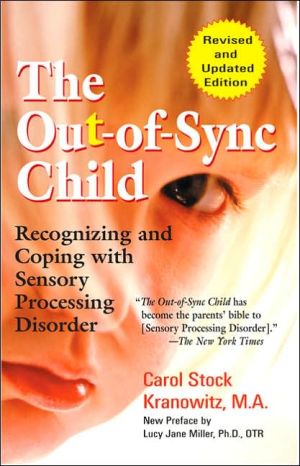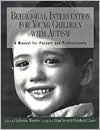Out-of-Sync Child: Recognizing and Coping with Sensory Processing Disorder
The Out-of-Sync Child broke new ground by identifying Sensory Processing Disorder, a common but frequently misdiagnosed problem in which the central nervous system misinterprets messages from the senses. This newly revised edition features additional information from recent research on vision and hearing deficits, motor skill problems, nutrition and picky eaters, ADHA, autism, and other related disorders.
Search in google:
NEWLY REVISED AND UPDATED The Out-of-Sync Child broke new ground by identifying Sensory Processing Disorder, a common but frequently misdiagnosed problem in which the central nervous system misinterprets messages from the senses. This newly revised edition features additional information from recent research on vision and hearing deficits, motor skill problems, nutrition and picky eaters, ADHA, autism, and other related disorders. Publishers Weekly Kranowitz, a teacher who has worked for 20 years in the field of sensory integration dysfunction and has developed a screening program for its early identification, writes intelligently about a bewildering topic. Fairly common (an estimated 12%-30% of children are affected), the disorder is nevertheless baffling to experts and parents alike, in part because of its diverse, contradictory symptoms: such children may be either hypo- or hypersensitive. Often erroneously diagnosed with attention deficit disorder (ADD) or labeled "difficult, picky, clumsy, oversensitive, or inattentive," children with SI dysfunction exhibit unusual responses to touching and being touched, and/or to moving and being moved. In concise, well-organized chapters, Kranowitz reveals how the tactile, vestibular (pertaining to gravity and movement) and propriaceptive (pertaining to joints, muscles and ligaments) senses operate. Checklists and sidebars throughout the text compare the "normal" child in various situations to the child with sensory integration dysfunction. Asserting SI dysfunction is best treated by occupational therapy, not by medication, Kranowitz helps clear the way for families to understand a disorder that they may suspect but not have been able to pinpoint. (Mar.)
\ Publishers Weekly - Publisher's Weekly\ Kranowitz, a teacher who has worked for 20 years in the field of sensory integration dysfunction and has developed a screening program for its early identification, writes intelligently about a bewildering topic. Fairly common (an estimated 12%-30% of children are affected), the disorder is nevertheless baffling to experts and parents alike, in part because of its diverse, contradictory symptoms: such children may be either hypo- or hypersensitive. Often erroneously diagnosed with attention deficit disorder (ADD) or labeled "difficult, picky, clumsy, oversensitive, or inattentive," children with SI dysfunction exhibit unusual responses to touching and being touched, and/or to moving and being moved. In concise, well-organized chapters, Kranowitz reveals how the tactile, vestibular (pertaining to gravity and movement) and propriaceptive (pertaining to joints, muscles and ligaments) senses operate. Checklists and sidebars throughout the text compare the "normal" child in various situations to the child with sensory integration dysfunction. Asserting SI dysfunction is best treated by occupational therapy, not by medication, Kranowitz helps clear the way for families to understand a disorder that they may suspect but not have been able to pinpoint. (Mar.)\ \







